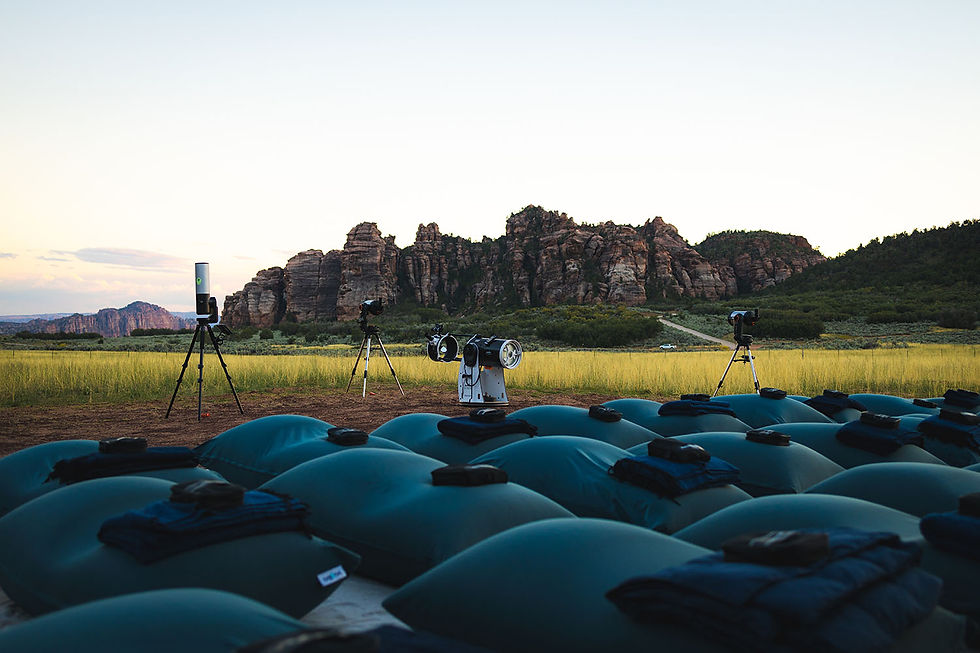Stargazing in Zion in July
- Matthias Schmitt

- Jul 5, 2022
- 3 min read
Updated: Apr 2
The hot summer months of July in the Northern Hemisphere bring the core of the Milky Way into splendor. Stargazing in Zion in July is a great time of year to view the milky way clearly and enjoy the evening in the desert! If you're wondering what to do at night in Zion, make sure to take the time to enjoy the dark skies and go stargazing while you are here this summer!
Find and visit dark sky locations to experience the magnificence of dazzling stars, bright clusters, and gas and dust that mark the bullseye of our home galaxy. An easy way to locate it is to look for the stinger of the Scorpion and the spout of the teapot (an asterism and part of Sagittarius). Then you are looking towards the center, which is about 24,000 light years away. Find a clear view of the Eastern horizon, get a camping chair, maybe binoculars, check the Moon phase (before First Quarter or after Full Moon) and then wait.
As it gets darker, your eyes will adjust to the night (avoid bright lights and use red headlamps) and if it is clear you will notice a hazy, milky cloud appearing. These aren’t clouds but the countless stars of your home galaxy that we cannot resolve with our natural eyesight. It is pretty special to experience that.

Source: Stellarium

Image of the Milky Way from our field. This is a 25-second exposure.
From our vantage point and by looking at other galaxies, we can infer what the Milky Way might look like from the outside. It is a spiral galaxy (similar to the Whirlpool galaxy) and spans roughly 100000 light years in diameter. The core holds the most mass and is the most luminous part. From Utah, we can discern the Northern arm of the MW. If you were to travel to the South of the equator, you would see the Southern arm, and it is a glorious sight. Plus you get to see the Large and Small Magellanic Clouds, which are satellite galaxies of the MW. Kinda like cousins that you visit occasionally.

Milky Way as we think it might look. Source: ESA
PLANETS
It was an amazing showing in late June of the planetary dance between Mercury, Venus, Mars, Jupiter and Saturn.

View of the lineup from Virgin, UT.
They continue to show during dawn, but Mercury has all but disappeared and will pop up in the evening at the end of July again. Saturn will show up late in the evening starting July 20th around 11 PM. We can’t wait to show you the rings of this cool planet!
THE EYES TO THE UNIVERSE

Artist Illustration James Webb. Source: NASA.
The James Webb Space Telescope is operating about 1 million miles from Earth and the public will get to see the first science images on July 12th! It will be mind-blowing. The diameter of the primary mirror is 21 feet (versus our biggest scope at 1 foot), which means it can collect A LOT of light. This helps to peer far back to the early times of the Universe. NASA has garnered support from lots of organizations to host community events to explain the operations of James Webb and share those images. Go to this website to find a community event near you: https://webbtelescope.org/news/first-images/events.
Enjoy Stargazing in Zion in July!
July is one of the best months for stargazing in Zion, with warm summer nights, breathtaking views of the Milky Way, and prime conditions for spotting celestial wonders. This month features the Delta Aquarid Meteor Shower, which peaks in late July, offering dazzling streaks across Zion’s dark skies. The Summer Triangle, a prominent asterism, shines brightly overhead, guiding stargazers to deep-space objects like the Ring Nebula and the Great Hercules Cluster. With long, clear nights and minimal light pollution, Zion National Park is one of the best places for stargazing in Utah. Make your summer nights unforgettable—book a stargazing tour with Stargazing Zion and experience the magic of the cosmos in one of the darkest skies in the country!



Comments